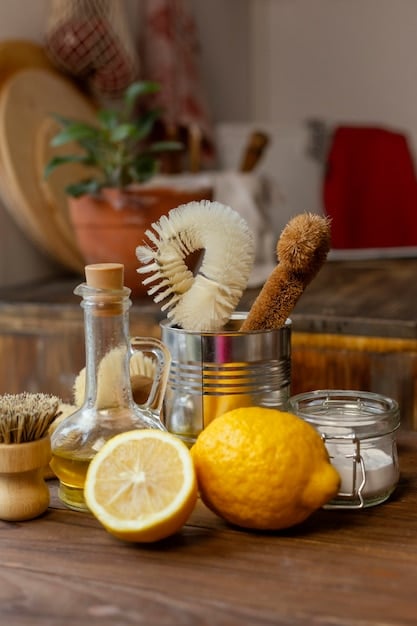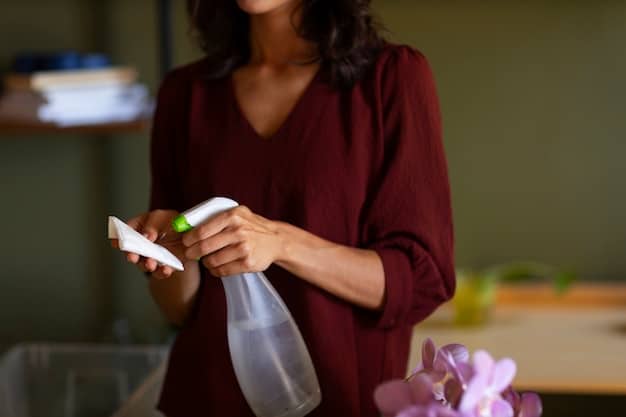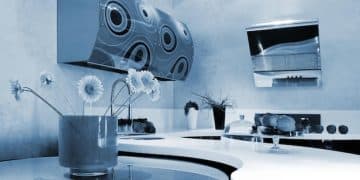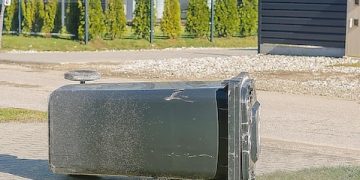Eco-Friendly Cleaning Products: Switch to Non-Toxic Alternatives and Save Money

Switching to eco-friendly cleaning products involves choosing non-toxic alternatives that protect health and the environment while also offering significant long-term financial savings through reduced chemical exposure and DIY solutions.
Are you looking to create a healthier home, protect the planet, and maybe even save a few dollars in the process? If so, diving into the world of eco-friendly cleaning products: switch to non-toxic alternatives and save money represents a significant step towards achieving all these goals. This comprehensive guide explores how making mindful choices about your cleaning supplies can transform your living space, benefit your well-being, and surprisingly, lighten your wallet.
The Hidden Costs of Conventional Cleaning Products
Many traditional cleaning products, despite their promise of sparkling surfaces, often come with a hidden baggage of environmental and health concerns. These are not merely abstract issues; they manifest in tangible ways, from indoor air pollution to accumulated waste. Understanding these less obvious costs is the first step toward appreciating the value of non-toxic alternatives. We’re talking about more than just the price tag on the shelf; it’s about the broader impact.
The chemicals found in conventional cleaners can pose serious health risks. Volatile Organic Compounds (VOCs), phthalates, and ammonia are just a few examples of substances frequently found in everyday cleaning supplies. When released into the air, these can contribute to respiratory issues, skin irritations, and even more severe long-term health problems. This reality leads many to seek safer options for their families, particularly in homes with children, pets, or individuals sensitive to harsh chemicals. This concern often outweighs initial cost considerations, highlighting the true value of healthier living environments.
Environmental impact and chemical runoff
Beyond our personal health, the environmental footprint of conventional cleaners is substantial. After use, these chemicals are rinsed down drains, eventually entering our water systems. This runoff contaminates rivers, lakes, and oceans, harming aquatic life and disrupting delicate ecosystems. The production of these chemicals also consumes significant energy and resources, often generating harmful byproducts.
- Water pollution: Chemicals like phosphates and nitrates contribute to algal blooms in waterways.
- Air pollution: Manufacturing processes release greenhouse gases and other pollutants.
- Waste generation: Single-use plastic packaging often ends up in landfills.
- Resource depletion: Reliance on fossil fuels for chemical production.
The cycle of production, consumption, and disposal creates a continuous strain on our planet. Recognizing this impact is crucial for informed decision-making. Shifting towards eco-friendly options isn’t just a trend; it’s a responsible choice for global well-being. It is about understanding that our everyday actions collectively contribute to the larger environmental picture.
Economic implications of chemical dependence
While eco-friendly products might sometimes have a higher upfront cost, consider the long-term economic implications of continually purchasing specialized chemical cleaners for every surface and spill. Many conventional cleaning routines involve buying multiple products, each designed for a specific task. This fragmentation can lead to significant spending over time. Moreover, health issues potentially linked to chemical exposure can translate into medical expenses and lost productivity. These indirect costs rarely appear on a shopping receipt but are very real.
Investing in versatile, concentrated eco-friendly ingredients like vinegar, baking soda, and castile soap often proves more economical in the long run. These basic components can replace a multitude of specialized cleaners, simplifying your cleaning cabinet and reducing overall expenditures. This approach aligns perfectly with the idea of making smarter, more sustainable choices. It’s about shifting from a disposable mindset to one of resourcefulness, where a few quality ingredients outperform many targeted chemical solutions.
We are constantly bombarded with advertisements for new cleaning solutions, each promising a unique benefit. However, the cumulative effect of these purchases adds up. By embracing the power of simpler, non-toxic alternatives, consumers can regain control over their household budgets while simultaneously promoting healthier living and a cleaner environment. It illustrates how eco-consciousness can also be financially savvy.
What Defines an Eco-Friendly Cleaning Product?
The term “eco-friendly” can be a bit of a buzzword, often used loosely by marketers. To effectively navigate the market and make truly sustainable choices, it’s essential to understand what genuinely defines an eco-friendly cleaning product. It’s more than just a label; it encompasses a product’s entire lifecycle, from ingredients to packaging and manufacturing processes.
At its core, an eco-friendly cleaning product minimizes harm to the environment and human health. This includes avoiding harsh chemicals, opting for renewable resources, and reducing waste. Transparency is a key indicator of a genuinely eco-friendly product. Reputable brands will openly list their ingredients and share their sustainability practices, allowing consumers to make informed decisions. This dedication to openness builds trust and supports conscious consumerism, moving beyond mere greenwashing.
Key characteristics of non-toxic alternatives
Non-toxic alternatives are characterized by their ingredient list—or rather, what’s absent from it. They prioritize natural, plant-based, and biodegradable components over synthetic chemicals. These products aim to achieve effective cleaning without leaving harmful residues or emitting noxious fumes. This focus on purity makes them safer for daily use around children and pets.
- Biodegradable ingredients: Products break down naturally without harming ecosystems.
- Plant-based formulations: Utilizes renewable resources like essential oils and vegetable extracts.
- Absence of harsh chemicals: Free from phosphates, phthalates, chlorine bleach, and ammonia.
- Reduced volatile organic compounds (VOCs): Minimizes indoor air pollution.
Beyond the ingredients, consideration is given to the overall impact. Many eco-friendly cleaners are concentrated, requiring less product per use and reducing the need for frequent repurchases. This not only stretches your dollar further but also minimizes packaging waste. The emphasis is on sustainability at every stage, offering a comprehensive solution for conscientious consumers.
Sustainable packaging solutions
Packaging plays a crucial role in a product’s environmental footprint. Truly eco-friendly cleaning brands go beyond just the product formulation to consider how their goods are delivered. This commitment often translates into innovative packaging solutions designed to minimize waste and promote circularity. The goal is to reduce plastic consumption and its devastating effect on landfills and oceans.
Many brands use recycled content, like post-consumer recycled (PCR) plastic, for their bottles. Others offer refillable systems, allowing customers to purchase concentrated refills and reuse existing containers repeatedly. Some even explore compostable or biodegradable packaging materials, taking sustainability to the next level. This holistic approach ensures that the entire product lifecycle, from production to disposal, aligns with environmental values. It’s an industry-wide shift towards a more responsible, less wasteful economy. Consumers are increasingly demanding these sustainable practices, pushing brands to innovate constantly.

DIY Eco-Friendly Cleaning Solutions That Save Money
One of the most empowering and cost-effective ways to embrace eco-friendly cleaning is by making your own solutions. This approach puts you in control of the ingredients, ensuring there are no hidden chemicals, and significantly cuts down on expenses. It’s surprisingly simple, uses common household items, and can be just as effective as store-bought alternatives. The satisfaction of knowing exactly what goes into your cleaning products is an added bonus.
The beauty of DIY cleaning lies in the versatility of a few basic, inexpensive ingredients. White vinegar, baking soda, castile soap, and essential oils are the superstars of natural cleaning. These items can be combined in various ways to tackle almost any cleaning challenge, from degreasing kitchen surfaces to scrubbing bathrooms and polishing floors. This simplicity contrasts sharply with the vast array of specialized products often found in conventional cleaning aisles.
Common household ingredients and their uses
Let’s delve into the power of these common ingredients. White vinegar, for example, is an excellent natural disinfectant and deodorizer. Its acetic acid content can cut through grease, dissolve mineral deposits, and kill many types of bacteria and mold. Similarly, baking soda is a gentle abrasive that can scrub away grime, absorb odors, and whiten surfaces. These workhorses are staples for a reason, proving their effectiveness through generations of use.
- White Vinegar: All-purpose cleaner, glass cleaner, descaler, fabric softener.
- Baking Soda: Scouring agent, odor absorber, drain cleaner, carpet freshener.
- Castile Soap: Dish soap, hand soap, gentle all-purpose cleaner, body wash.
- Lemon Juice: Stain remover, brightener, natural bleach, deodorizer.
- Essential Oils (e.g., Tea Tree, Lemon, Lavender): Natural disinfectants, air fresheners, adds pleasant scent.
These ingredients are not only readily available and inexpensive but also incredibly safe. You won’t have to worry about inhaling harsh fumes or skin irritation, making them ideal for everyday cleaning tasks. The simplicity of these natural compounds provides a refreshing alternative to complex chemical formulations, promoting both health and sustainability within the home environment. It’s about getting back to basics.
Recipes for effective homemade cleaners
Creating your own cleaning solutions is straightforward. Here are a few simple recipes that demonstrate the power of these natural ingredients, offering effective and budget-friendly alternatives to store-bought products. These recipes eliminate the need for harsh chemicals, making your home a safer and healthier place without compromising on cleanliness. They prove that powerful cleaning doesn’t require complex ingredients.
For an all-purpose cleaner, mix equal parts white vinegar and water in a spray bottle. Add a few drops of your favorite essential oil for a pleasant scent. This solution is perfect for countertops, sinks, and general surface cleaning. For tougher jobs, a paste made from baking soda and a little water can tackle stubborn grime on stove tops or in bathtubs. These basic combinations cover a vast range of household cleaning needs, simplifying your routine.
- All-Purpose Spray: 1 cup white vinegar, 1 cup water, 10-15 drops essential oil (lemon or tea tree). Mix and use on all surfaces.
- Scouring Paste: ½ cup baking soda, enough water to form a paste. Apply with a sponge to sinks, tubs, and stovetops.
- Glass Cleaner: 2 cups water, ¼ cup white vinegar, ½ tsp liquid castile soap. Spray and wipe with a microfiber cloth for streak-free shine.
- Drain Cleaner/Deodorizer: Pour ½ cup baking soda down drain, follow with ½ cup white vinegar. Let sit 30 min, then flush with hot water.
These recipes are not only effective but also incredibly versatile. By mastering a few basic formulas, you can replace a multitude of specialized cleaners, saving significant money over time. It’s a testament to the fact that you don’t need complex chemistry to maintain a clean and healthy home. The satisfaction of knowing you’re using pure, natural ingredients adds to the appeal of this approach.
Choosing Store-Bought Eco-Friendly Options Wisely
While DIY solutions are incredibly effective and economical, there are times when purchasing pre-made eco-friendly cleaners is a more convenient option. The market for these products has expanded significantly, offering a wide array of choices. However, not all “green” claims are created equal. Knowing how to choose wisely ensures you’re genuinely investing in products that align with your values and deliver on their promises. Navigating the sometimes-dense landscape of eco-labels can be challenging, but an informed approach simplifies the process.
When selecting store-bought options, look beyond surface-level marketing. True eco-friendly products often carry specific certifications or boast transparent ingredient lists. These details provide tangible proof of a brand’s commitment to sustainability and health, separating genuine efforts from mere greenwashing. A critical eye is necessary to ensure your purchases truly contribute to a healthier home and planet.
Understanding certifications and labels
Certifications from reputable third-party organizations are invaluable indicators of a product’s environmental and health credentials. These seals assure that the product has been rigorously tested and meets specific standards for biodegradability, non-toxicity, and sustainable sourcing. Common certifications include EPA Safer Choice, Leaping Bunny (for cruelty-free), and Ecocert, among others. Familiarizing yourself with these labels empowers you to make quick, informed decisions on the go.
- EPA Safer Choice: Identifies products made with ingredients that are safer for human health and the environment.
- ECOCERT: Certifies that products meet strict standards for natural and organic ingredients, and sustainable production.
- Leaping Bunny: Guarantees no animal testing at any stage of product development.
- USDA Organic: While more common for food, some cleaning specific ingredients may carry this.
Beyond formal certifications, look for explicit statements about biodegradability, plant-based ingredients, and PCR content in packaging. A brand’s transparency regarding their supply chain and manufacturing processes also speaks volumes. These details, though small, collectively paint a picture of a company’s true commitment to environmental responsibility. They help differentiate between genuine efforts and simple marketing ploys, reinforcing consumer trust.
Reading ingredient lists carefully
The ingredient list is your most powerful tool when evaluating store-bought cleaners. Don’t rely solely on front-of-package claims like “natural” or “gentle,” which can be unregulated and misleading. Instead, scrutinize the fine print. Look for an easy-to-understand list of ingredients, avoiding products that use vague terms like “fragrance” without specifying components. This level of detail empowers you to identify and avoid potentially harmful substances and make choices you feel good about.
Prioritize products with simple, recognizable ingredients. If you can’t pronounce it or don’t know what it is, it’s worth researching further. Be wary of common irritants and problematic chemicals such as phthalates, parabens, synthetic fragrances, chlorine, and ammonia. Many eco-friendly brands pride themselves on their ‘free from’ lists, explicitly stating what harmful chemicals they exclude. This transparency contrasts with brands that obscure their formulas, indicating a stronger commitment to consumer health and environmental safety. It’s about making educated choices rather than relying on marketing. By taking the time to read those labels, you become a more informed, responsible consumer, benefiting both yourself and the planet.

Beyond Products: Sustainable Cleaning Practices
While choosing eco-friendly cleaning products is a significant step, true sustainability in household cleaning extends beyond the products themselves. It encompasses a holistic approach to how we clean, from our water usage to our choice of cleaning tools. Embracing sustainable cleaning practices involves mindful habits that reduce waste, conserve resources, and minimize our environmental footprint. It’s about creating a routine that supports both a clean home and a healthier planet.
Effective sustainable cleaning often boils down to simplicity and efficiency. It means leveraging the power of reusable materials, optimizing our use of water and energy, and being more intentional about when and how we clean. These practices not only enhance the environmental benefits of your eco-friendly products but can also lead to further savings and a more streamlined cleaning routine. By integrating these habits, we amplify our positive impact.
Reducing waste: reusable tools and mindful consumption
One of the easiest ways to boost your cleaning routine’s sustainability is by swapping disposable items for reusable ones. Think microfiber cloths instead of paper towels, reusable sponges, and durable brushes. These tools often clean more effectively and last longer, significantly reducing landfill waste and saving you money on repeat purchases. Investing in quality, long-lasting cleaning implements pays dividends over time.
- Microfiber cloths: Highly effective for trapping dirt and dust, washable and reusable.
- Reusable sponges: Choose plant-based or biodegradable options.
- Airing out rooms: Reduces reliance on air fresheners and improves indoor air quality.
- Choosing refillable packaging: Minimizes plastic waste over time.
Beyond tools, consider your overall consumption habits. Do you really need a new product for every minor spill? Often, a simple cloth and water, or one of your DIY solutions, will suffice. Buying in bulk or opting for concentrated products also reduces packaging waste. This mindful approach extends the benefits of eco-friendly products by minimizing associated waste, fostering a more sustainable home environment. It’s about being resourceful and consciously reducing your footprint, recognizing that every small choice accumulates into a significant positive impact.
Water and energy conservation in cleaning
Cleaning, particularly extensive cleaning, often involves significant water and energy consumption. Adopting practices that conserve these precious resources is vital for a truly eco-friendly approach. This means being mindful of how much water you use for rinsing, opting for cold water when possible, and making smart choices about running appliances like dishwashers and washing machines. Every drop and joule counts.
Simple habit changes can make a big difference. For instance, instead of letting the tap run continuously while washing dishes or rinsing surfaces, turn it off between uses. When doing laundry, try to run full loads and use cold water cycles, which are effective for most cleaning tasks and save energy on heating. These small adjustments contribute to substantial savings in utility bills and a reduced environmental footprint, embodying the spirit of sustainable living. They exemplify how eco-friendly living is integrated into daily habits, extending beyond mere product choices.
Optimizing appliance usage also plays a role. If your dishwasher has an eco-mode, use it. Consider air-drying dishes and laundry whenever feasible, minimizing the need for energy-intensive dryers. These practices illustrate that sustainable cleaning isn’t just about what you use, but how you use it. It’s an integration of product choice and conscious action, creating a genuinely eco-conscious home environment. This holistic view of sustainability goes beyond the readily visible, delving into the unseen habits that collectively shape our environmental impact.
The Long-Term Benefits: Health, Environment, and Savings
The decision to switch to eco-friendly cleaning products: switch to non-toxic alternatives and save money isn’t just about making minor adjustments to your shopping list; it’s an investment in your well-being, the planet’s health, and your financial future. The long-term benefits of this transition extend far beyond immediate satisfaction, creating a ripple effect that touches every aspect of your household and beyond. It’s a holistic improvement that reinforces the conscious choice for sustainable living.
Embracing eco-friendly cleaning is a testament to the power of small, consistent changes. Over time, the cumulative effect of reduced chemical exposure, diminished environmental impact, and accumulated financial savings becomes profoundly clear. These benefits are not merely theoretical; they are observable in improved indoor air quality, a healthier planet, and a healthier bank account. It highlights how these personal decisions contribute to a larger, more positive global narrative.
Improved indoor air quality and personal health
One of the most immediate and tangible benefits of ditching conventional cleaners is a dramatic improvement in indoor air quality. By eliminating VOCs and other irritating compounds, you create a home environment free from persistent chemical odors and airborne pollutants. This significantly reduces the risk of respiratory issues, allergies, headaches, and skin irritations often associated with chemical cleaning agents. The cleaner air makes a palpable difference in daily life, especially for vulnerable individuals.
For families with young children or pets, the peace of mind that comes from knowing surfaces are free of toxic residues is invaluable. Children often spend more time on floors and put objects in their mouths, making them particularly susceptible to chemical exposure. Switching to non-toxic alternatives ensures a safer play and living space. This shift fosters a healthier environment where everyone can breathe easier and thrive, reducing the hidden health burdens unknowingly imposed by conventional cleaning. It’s a proactive step towards preventative health.
Contributing to a healthier planet
Every time you choose an eco-friendly cleaning product or opt for a DIY solution, you are actively contributing to the protection of our planet. This conscious consumerism reduces the demand for products manufactured with harmful chemicals, encourages sustainable sourcing, and lessens the burden on our landfills and water systems. Your individual choices, when multiplied across a community, create a powerful force for environmental change, driving systemic shifts towards greener practices.
The cumulative effect of reduced chemical runoff, decreased plastic waste, and lower energy consumption from concentrated products translates into clearer waterways, cleaner air, and healthier ecosystems. It’s a direct way to combat pollution and preserve biodiversity. This commitment extends beyond your home, influencing industry practices and encouraging other consumers to follow suit. It’s about being part of a larger movement towards a more sustainable and equitable future, one conscious choice at a time.
Long-term financial savings and resourcefulness
While the initial motivation for switching to eco-friendly cleaning might be health or environmental concern, the long-term financial savings are a compelling added benefit. As discussed, DIY solutions are remarkably inexpensive, leveraging common household items that are often bought in bulk for other purposes. This versatility means less money spent on specialized single-purpose cleaners, freeing up funds for other priorities. The reduction in recurring purchases quickly adds up.
Even when purchasing pre-made eco-friendly products, many are concentrated, reducing the amount needed per use and extending the life of each bottle. The investment in reusable cleaning tools like microfiber cloths also eliminates the constant need to buy disposable items. Over months and years, these small savings accumulate into significant amounts, reinforcing the economic wisdom of sustainable choices. It’s about becoming more resourceful and less reliant on consumer products, demonstrating that a greener lifestyle can also be a more frugal one. This financial benefit serves as a practical reinforcement for sustainable living, showing that what’s good for the planet can also be good for your wallet.
| Key Point | Brief Description |
|---|---|
| 🌱 Health Benefits | Reduces exposure to harsh chemicals, improving indoor air quality and minimizing allergic reactions. |
| 🌎 Environmental Impact | Minimizes water pollution, lowers energy consumption, and reduces plastic waste from packaging. |
| 💰 Cost Savings | DIY solutions and concentrated products lead to significant long-term financial savings. |
| ✨ Effective Cleaning | Natural ingredients like vinegar and baking soda are proven, powerful cleaners without harsh residues. |
Frequently asked questions
▼
Yes, many high-quality eco-friendly cleaning products and DIY solutions are just as effective, if not more so, than their conventional counterparts. Ingredients like white vinegar, baking soda, and essential oils possess natural properties that effectively clean, disinfect, and deodorize. The key is to understand their specific uses and applications for optimal results in various cleaning scenarios.
▼
Absolutely. While some store-bought eco-friendly products might have a slightly higher upfront cost, making your own cleaners from inexpensive ingredients like vinegar and baking soda offers significant long-term savings. Additionally, many eco-friendly brands sell concentrated formulas, meaning a single bottle lasts longer, reducing the frequency of purchases and overall expenditure.
▼
When selecting cleaning products, it’s advisable to avoid harsh chemicals such as phthalates, volatile organic compounds (VOCs), chlorine bleach, ammonia, parabens, and synthetic fragrances. These substances can contribute to indoor air pollution, respiratory issues, skin irritation, and may pose long-term health risks. Prioritizing products free from these ingredients ensures a safer home environment for all residents.
▼
Eco-friendly cleaning products are designed to minimize environmental harm throughout their lifecycle. They typically feature biodegradable ingredients that break down safely without contaminating water systems. Many also use sustainable packaging, such as recycled or refillable options, which helps reduce plastic waste in landfills and oceans. Their production processes also tend to be more energy-efficient and less polluting.
▼
Yes, several reputable certifications can help guide your purchases. Look for labels such as EPA Safer Choice, Leaping Bunny (for cruelty-free products), and ECO_CERT, which indicate that products meet strict environmental and health standards. These third-party certifications assure you that the product has undergone rigorous testing and adheres to specific criteria for sustainability and non-toxicity.
Conclusion
Embracing eco-friendly cleaning products: switch to non-toxic alternatives and save money is more than a trend; it’s a practical and beneficial lifestyle choice. This transition offers a myriad of advantages, from creating a healthier indoor environment free from harmful chemicals to significantly reducing your household’s ecological footprint. Moreover, by opting for DIY solutions or strategically choosing store-bought concentrates, measurable financial savings become a pleasant and consistent reality. It allows you to clean with confidence, knowing you are protecting your family, nurturing the planet, and managing your finances wisely. Make the switch today and experience the profound benefits of a cleaner, greener, and more economical home.





